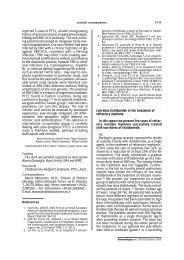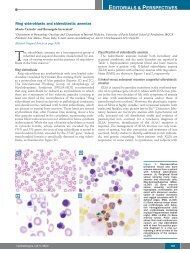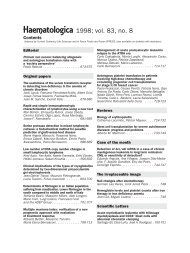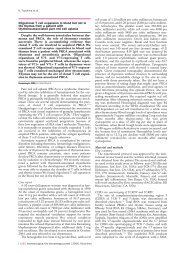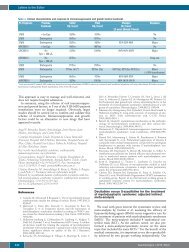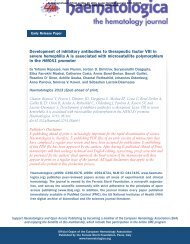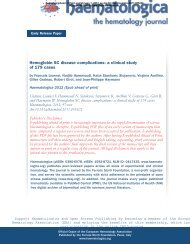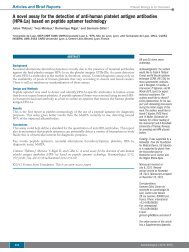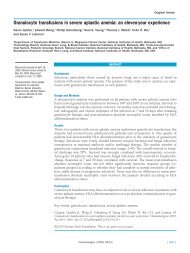LETTERS TO THE EDITOR - Haematologica
LETTERS TO THE EDITOR - Haematologica
LETTERS TO THE EDITOR - Haematologica
You also want an ePaper? Increase the reach of your titles
YUMPU automatically turns print PDFs into web optimized ePapers that Google loves.
<strong>LETTERS</strong> <strong>TO</strong> <strong>THE</strong> EDI<strong>TO</strong>R<br />
Changes in parameters of oxidative stress and<br />
free iron biomarkers during treatment with<br />
deferasirox in iron-overloaded patients with<br />
myelodysplastic syndromes<br />
Approximately 60-80% of patients with myelodysplastic<br />
syndromes (MDS) present with symptomatic<br />
anemia and, of these, 80-90% will require red blood cell<br />
(RBC) transfusions as supportive therapy. 1,2 Excess transfusional<br />
iron causes accumulation of labile plasma iron<br />
(LPI), the pathological form of non-transferrin-bound<br />
iron. Labile plasma iron is redox active and is rapidly<br />
taken up by cells, leading to a rise in the labile iron pool<br />
(LIP) 3,4 and catalyzing generation of reactive oxygen<br />
species (ROS). 5 The ensuing oxidative stress 6 and associated<br />
decrease in antioxidants such as reduced glutathione<br />
(GSH) cause oxidation of lipids, proteins and<br />
DNA, cell death and organ damage. Iron overload has<br />
thus been shown to affect morbidity and mortality in<br />
transfusion-dependent myelodysplastic syndrome<br />
patients. 7<br />
Here we report results from a 3-month, single-arm,<br />
open-label trial conducted at five centers in Israel. The<br />
effects of deferasirox (Exjade ® ), a once-daily oral iron<br />
chelator, on parameters of oxidative stress, chelatable<br />
labile iron pool, labile plasma iron and serum ferritin levels,<br />
were assessed in 31 male and female myelodysplastic<br />
syndrome patients aged 18 years or over with an<br />
International Prognostic Scoring System (IPSS) score of<br />
Low or Intermediate-1 risk, who had received 20 units or<br />
more of packed red blood cells, and had evidence of iron<br />
overload (serum ferritin >1,000 ng/mL). Oxidative stress<br />
parameters were measured every 3-4 weeks in red blood<br />
cells, platelets and polymorphonuclear leukocytes<br />
(PMN) as previously described. 8 Creatinine analysis was<br />
performed in all patients weekly for the first month.<br />
Nineteen patients completed the study (Table 1); there<br />
were 12 withdrawals due to adverse events (n=4; 36%),<br />
death (n=2; 18%), transformation to high-grade MDS<br />
(n=1; 9%), eligibility criteria (n=1; 9%), withdrawal of<br />
consent (n=1; 9%) and unspecified reasons (n=3; 27%).<br />
The baseline characteristics demonstrate high levels of<br />
oxidative stress and iron overload in these transfused<br />
patients with myelodysplastic syndromes; levels of reactive<br />
oxygen species were higher than the normal range<br />
while levels of the antioxidant reduced glutathione were<br />
lower than normal. These results confirm our previous<br />
study, which also showed increased oxidative stress in<br />
patients with myelodysplastic syndromes. 9<br />
Sixteen patients received daily deferasirox 20<br />
mg/kg/day for three months, while the dose was lowered<br />
to 4-6 mg/kg/day after one month in 3 patients in<br />
response to adverse events (mainly gastrointestinal,<br />
increased creatinine and rash). Sixteen patients were<br />
treated for 82-105 days, 2 patients for 112 and 120 days,<br />
respectively, and one patient for 38 days. The mean<br />
duration of treatment with deferasirox was 91±16 (range<br />
38-120) days. The treatment resulted in significant<br />
reductions in cellular markers of oxidative stress (Figure<br />
1) demonstrating the benefits of short-term iron chelation<br />
in patients with myelodysplastic syndromes.<br />
Baseline levels of labile iron pool and serum ferritin<br />
indicated that these patients were iron overloaded.<br />
Treatment with deferasirox for three months significantly<br />
reduced the levels of intra- and extra-cellular free iron<br />
species. Geometric mean levels of labile iron pool<br />
decreased from 19 (95% confidence interval (CI) 17-25)<br />
to 14 (12-19) mean fluorescence channel (MFC; P=0.002)<br />
in red blood cells, and from 22 (19-31) to 18 (15-27) MFC<br />
(P
Letters to the Editor<br />
*Cell fluorescence is proportional to ROS and GSH but inversely proportional to lipid peroxidation<br />
Figure 1. Dynamic changes in oxidative stress parameters in RBC, platelets and PMN, at baseline and after a mean of three months of<br />
deferasirox therapy.<br />
of conclusive prospective data, the value of iron chelation<br />
therapy for improving long-term survival of patients<br />
with myelodysplastic syndromes is still unknown. 11,12<br />
Additional clinical studies are required to fully understand<br />
the mechanisms behind the changes in the studied<br />
parameters and to evaluate their correlation with longterm<br />
morbidity, mortality and quality of life.<br />
Hussam Ghoti, 1 Eitan Fibach, 2 Drorit Merkel, 3<br />
Galit Perez-Avraham, 4 Sigal Grisariu 2<br />
and Eliezer A Rachmilewitz 1<br />
1<br />
Hematology, Edith Wolfson Medical Center, Holon; 2 Hematology,<br />
Hadassah - Hebrew University Medical Center, Jerusalem;<br />
3<br />
Hematology, Chaim Sheba Medical Center, Tel-Hashomer; and<br />
4<br />
Hematology, Soroka University Medical Center, Beer-Sheva,<br />
Israel<br />
Key words: iron overload, oxidative stress, myelodysplastic syndromes,<br />
reactive oxygen species.<br />
Acknowledgments: this work was supported by Novartis<br />
Pharmaceuticals. Financial support for medical editorial assistance<br />
was provided by Novartis Pharmaceuticals. We thank Roy<br />
Mazucco for the medical editorial assistance with this manuscript.<br />
We also thank Arnon Nagler, Itai Levi and Elizabeth Naparstek for<br />
providing patients, Johnny Amer for technical assistance, and Aliza<br />
Ackerstein MSc for medical input.<br />
Clinicaltrials.gov Identifier: NCT00452660<br />
Correspondence: Eliezer A Rachmilewitz, Head of the Hematology<br />
Department, Edith Wolfson Medical Center, Holon, Israel.<br />
Tel: + 972 3 5028778. Fax: + 972 3 5028776.<br />
E-mail: rachmilewitz@wolfson.health.gov.il<br />
Citation: Ghoti H, Fibach E, Merkel D, Perez-Avraham G,<br />
Grisariu S and Rachmilewitz EA. Changes in parameters<br />
of oxidative stress and free iron biomarkers during treatment with<br />
deferasirox in iron-overloaded patients with myelodysplastic<br />
syndromes. <strong>Haematologica</strong>. 2010;95(8):1433-1434.<br />
doi:10.3324/haematol.2010.024992<br />
References<br />
1. Greenberg PL, Young NS, Gattermann N. Myelodysplastic syndromes.<br />
Hematology Am Soc Hematol Educ Program. 2002;136-<br />
61.<br />
2. Hellström-Lindberg E. Management of anemia associated with<br />
myelodysplastic syndrome. Semin Hematol. 2005;42(2 Suppl<br />
1):S10-S13.<br />
3. Cabantchik ZI, Breuer W, Zanninelli G, Cianciulli P. LPI-labile<br />
plasma iron in iron overload. Best Pract Res Clin Haematol.<br />
2005;18(2):277-87.<br />
4. Breuer W, Shvartsman M, Cabantchik ZI. Intracellular labile iron.<br />
Int J Biochem Cell Biol. 2008;40(3):350-4.<br />
5. Hershko C, Link G, Cabantchik I. Pathophysiology of iron overload.<br />
Ann NY Acad Sci. 1998;850:191-201.<br />
6. Jones DP, Carlson JL, Mody VC, Cai J, Lynn MJ, Sternberg P.<br />
Redox state of glutathione in human plasma. Free Radic Biol Med.<br />
2000;28(4):625-35.<br />
7. Malcovati L, Della Porta MG, Pascutto C, Invernizzi R, Boni M,<br />
Travaglino E, et al. Prognostic factors and life expectancy in<br />
myelodysplastic syndromes classified according to WHO criteria:<br />
a basis for clinical decision making. J Clin Oncol.<br />
2005;23(30):7594-603.<br />
8. Amer J, Ghoti H, Rachmilewitz E, Koren A, Levin C, Fibach E.<br />
Red blood cells, platelets and polymorphonuclear neutrophils of<br />
patients with sickle cell disease exhibit oxidative stress that can<br />
be ameliorated by antioxidants. Br J Haematol. 2006;132(1):108-<br />
13.<br />
9. Ghoti H, Amer J, Winder A, Rachmilewitz E, Fibach E. Oxidative<br />
stress in red blood cells, platelets and polymorphonuclear leukocytes<br />
from patients with myelodysplastic syndrome. Eur J<br />
Haematol. 2007;79(6):463-7.<br />
10. List AF, Baer MR, Steensma D, Raza A, Esposito J, Virkus J, et al.<br />
Iron chelation with deferasirox (Exjade®) improves iron burden in<br />
patients with myelodysplastic syndromes (MDS). Blood.<br />
2008;112(11):abst 634.<br />
11. DeLoughery TG. Iron: The fifth horseman of the apocalypse? Am<br />
J Hematol. 2009;84(5):263-4.<br />
12. Steensma DP. Myelodysplasia paranoia: Iron as the new radon.<br />
Leuk Res. 2009;33(9):1158-63.<br />
1434 haematologica | 2010; 95(8)



